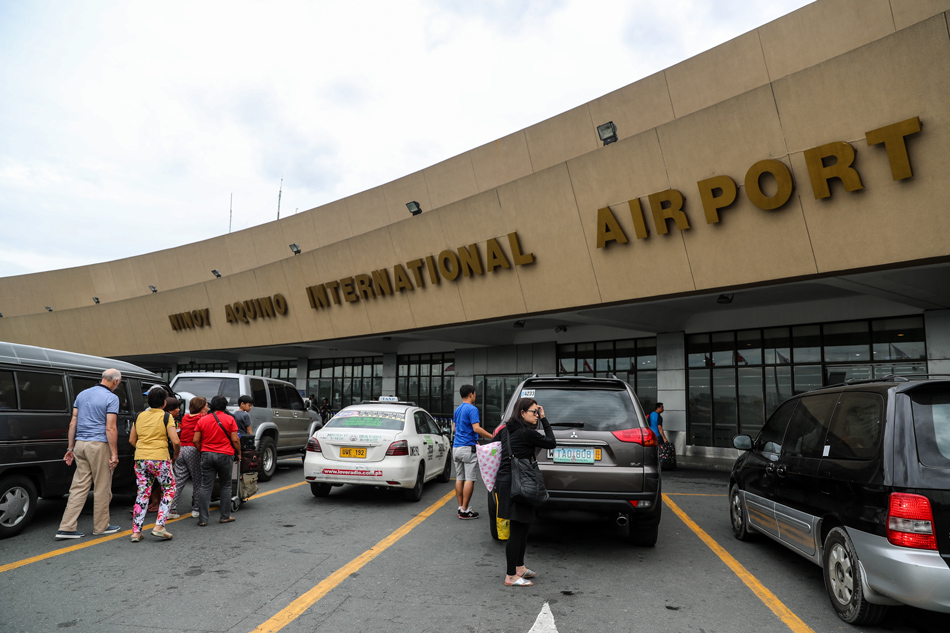NAIA imposes additional visual checks on passengers vs. monkeypox | ABS-CBN
ADVERTISEMENT

Welcome, Kapamilya! We use cookies to improve your browsing experience. Continuing to use this site means you agree to our use of cookies. Tell me more!
NAIA imposes additional visual checks on passengers vs. monkeypox
NAIA imposes additional visual checks on passengers vs. monkeypox
Jacque Manabat,
ABS-CBN News
Published Aug 02, 2022 04:55 PM PHT
|
Updated Aug 02, 2022 07:25 PM PHT
MANILA — As a precaution against monkeypox, passengers at the Ninoy Aquino International Airport (NAIA) are being asked to roll up their sleeves for a quick visual inspection by quarantine medical officers.
MANILA — As a precaution against monkeypox, passengers at the Ninoy Aquino International Airport (NAIA) are being asked to roll up their sleeves for a quick visual inspection by quarantine medical officers.
This is among the health safety checks implemented by the Bureau of Quarantine (BOQ) at NAIA's gates, following the World Health Organization's (WHO) declaration of monkeypox as a global health emergency.
This is among the health safety checks implemented by the Bureau of Quarantine (BOQ) at NAIA's gates, following the World Health Organization's (WHO) declaration of monkeypox as a global health emergency.
The additional step is done on top of thermal scanning which detects travelers' body temperatures.
The additional step is done on top of thermal scanning which detects travelers' body temperatures.
“Pinapataas natin ang jackets hanggang maaari makita natin iyong signs and symptoms. We will have primary screening using the thermal scanner if the medical officer sees that this person needs to be evaluated further we do a secondary screening," NAIA quarantine medical officer Dr. Rhaychelle La Rosa said.
“Pinapataas natin ang jackets hanggang maaari makita natin iyong signs and symptoms. We will have primary screening using the thermal scanner if the medical officer sees that this person needs to be evaluated further we do a secondary screening," NAIA quarantine medical officer Dr. Rhaychelle La Rosa said.
ADVERTISEMENT
Passengers who register a body temperature higher than 37.5 degrees, and with rashes on hands and arms, are escorted to an exit separate from other passengers.
Passengers who register a body temperature higher than 37.5 degrees, and with rashes on hands and arms, are escorted to an exit separate from other passengers.
The traveler with rashes and high fever will be sent to the BOQ clinic for a second look before bringing them to Research Institute for Tropical Medicine (RITM).
The traveler with rashes and high fever will be sent to the BOQ clinic for a second look before bringing them to Research Institute for Tropical Medicine (RITM).
But BOQ said the additional step of rolling up sleeves might not entirely prevent monkeypox from entering the country, and recommended that additional tests should be conducted.
But BOQ said the additional step of rolling up sleeves might not entirely prevent monkeypox from entering the country, and recommended that additional tests should be conducted.
If a passenger is confirmed to have contracted monkeypox, the BOQ will also reach out to that person's close contacts to see if whether they are showing symptoms, La Rosa said.
If a passenger is confirmed to have contracted monkeypox, the BOQ will also reach out to that person's close contacts to see if whether they are showing symptoms, La Rosa said.
Passengers cleared of the thermal scan and visual checks will be advised to proceed to Philippine Coast Guard (PCG) booths, where they will be asked to present a One Health Pass QR code and vaccination card.
Passengers cleared of the thermal scan and visual checks will be advised to proceed to Philippine Coast Guard (PCG) booths, where they will be asked to present a One Health Pass QR code and vaccination card.
The One Health Passcode may be processed 2 days before the flight.
The One Health Passcode may be processed 2 days before the flight.
If the passenger could not complete 2 vaccine shots and a booster, he or she must present a negative RT-PCR result taken 48 hours before the flight or a negative antigen test result taken 24 hours before the flight.
If the passenger could not complete 2 vaccine shots and a booster, he or she must present a negative RT-PCR result taken 48 hours before the flight or a negative antigen test result taken 24 hours before the flight.
If the passenger fails to present a negative test result, he or she will undergo quarantine for 5 days.
If the passenger fails to present a negative test result, he or she will undergo quarantine for 5 days.
RELATED VIDEO:
ADVERTISEMENT
ADVERTISEMENT



